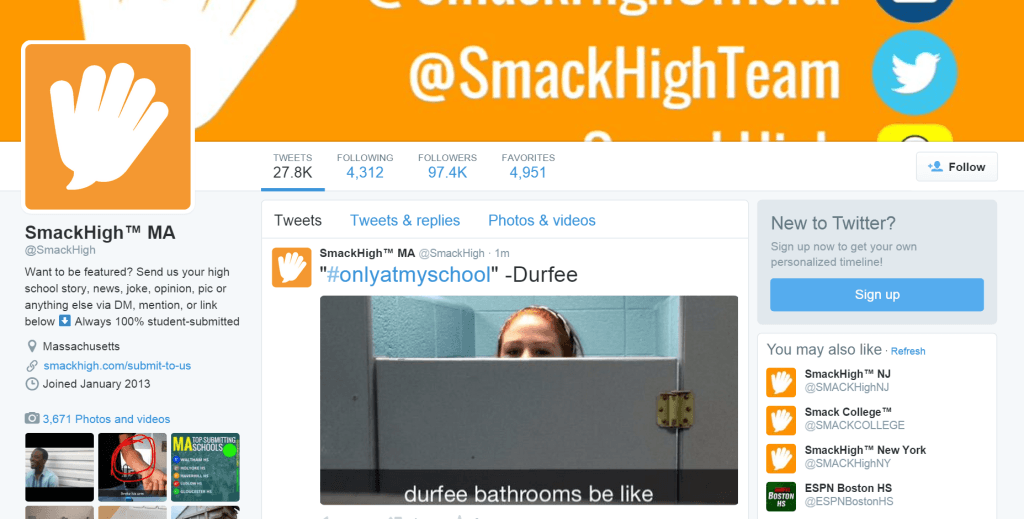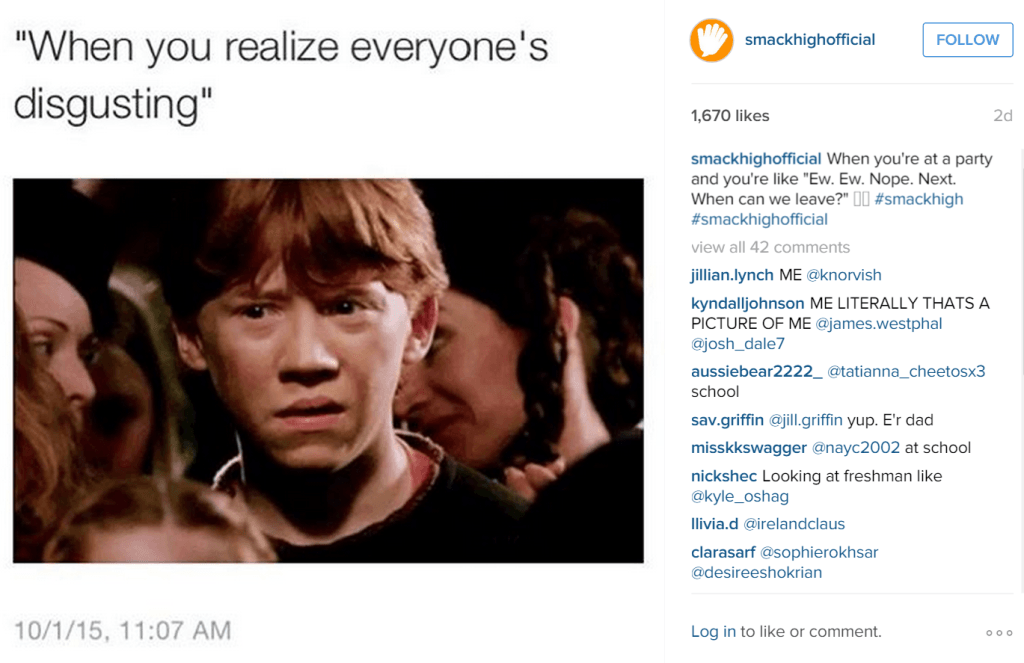SmackHigh: A social media platform fighting teen bullying

SmackHigh aims to build inter-school community through friendly smack talk and shared experiences in a safe online space
Can SmackHigh, a new social media platform for teens help reduce bullying?
SmackHigh curates content from high school students across geographical regions and features them on the platform’s Twitter, Instagram, and Snapchat feeds as well as on their mobile app. Dedicated feeds by state allow for more focused discussion and building of inter-school community through friendly smack talk and shared experiences.
The company started as a joke in 2013, when high school students in Massachusetts started using the Twitter account “SmackHigh” to talk about sports and social happenings. Two years later, SmackHigh has a following of over 850,000 high school students and is in 26 states [1]. It’s not hard to see why students like it:
Alright it’s cool, but how again does this fight against bullying?
Unlike other anonymous social media platforms, SmackHigh using volunteer brand ambassadors to filter submissions before posting them on the platform’s social media channels. The platform’s website clearly states the community values, and asks the community not to post threats, hateful content, and harassment and bullying. This can be contrasted with the popular social media platform Yik Yak, which was used by students to find parties within a 5-mile radius but had issues of bullying and racist comments.
In the Boston Globe’s recent profile of the company, it notes that users have started to censor themselves after observing that the brand ambassadors were blocking negative posts about specific classmates. SmackHigh now has over 7,000 brand ambassadors curating submissions. Although it’s difficult to claim that SmackHigh is preventing bullying outside of their platform, it is providing a safe space for students to interact.
What is SmackHigh doing to grow?
SmackHigh’s platform benefits from both direct and indirect network effects and scale is critical. On the direct network effects, more students on the platform means more varied and interesting content for each student user. And SmackHigh has built a partnership with Atlanta’s Fox 5 Sports which can serve as an interesting model for indirect network effects [2]. SmackHigh uses its platform to tell Fox what the most popular game of the week is in Georgia. In return, Fox broadcasts the game and shows the SmackHigh brand.
To support its growth, SmackHigh has attracted $1.65 Mn in seed funding from FlyBridge Capital Partners, Boston Seed Capital, and investor Wayne Chang. It’s also in the TechStars Boston 2015 class.
Looking to the future…
SmackHigh has a lot of potential, but it remains to be seen whether the initial user growth can be sustained. Students have many social media outlets, and it’s hard to tell whether many students will seek the inter-school community that SmackHigh offers or if most will just stay with their existing friend circles. And now that SmackHigh has raised capital, they will need to find ways to generate a return for their investors, which means that the indirect network effects need to be a high priority. If SmackHigh can generate enough value for partners like Fox, they may be able to charge for their services.
I remain hopeful for SmackHigh, as I do think many high school students would find value in a safe social space online. And it really is pretty entertaining.






Angela, this is a valuable post! Thanks for bringing up this important subject. It is great to see that investors’ money is also being channeled into ventures with such positive mission. I hope SmackHigh succeeds and gains more traction among teenagers but I do have some observations and questions about their business model.
First of all, they are a late entrant into a social networking space dominated by a few powerful players. That is a pretty heroic move. However, what I believe might work in their favor is that they are addressing an important problem for many users of other online social networks – the need for a safe environment for teenagers to socialize. The question is though whether these are the parents, the schools, etc. who see the real value in this network (and would prefer to see their children use SmackHigh rather than FB) or whether there will be enough interest from students themselves. Do you have any ideas for how the company could increase network effects?
Another problem might be user attrition, while we tend to maintain FB beyond high school, this would not necessarily be the case for SmackHigh. Additionally, due to its curated model, scalability might be limited.
Finally, there is the question of monetization. What works in their favor is that one side of the platform (e.g., advertisers, TV stations, etc.) are paying clients, yet those who curate the content do it for free just because they are passionate about the mission. This model is somewhat similar to the model I describe in my post on BzzAgent, i.e., a company achieves high margins by leveraging a low-cost network of devoted users.